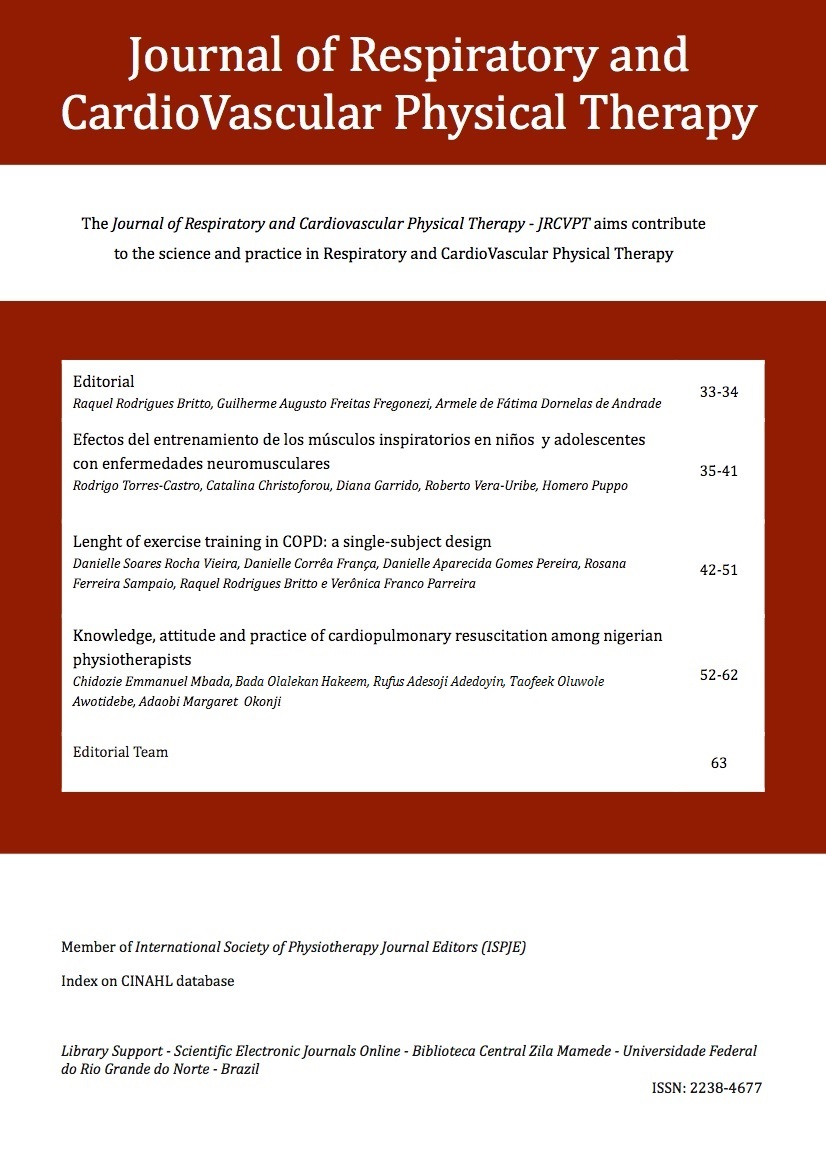Length of exercise training in COPD: a single-subject design
Keywords:
Chronic Obstructive Pulmonary Disease (COPD), exercise training, single-subject design.Abstract
Backgroud: The minimum duration of exercise training in patients with Chronic Obstructive Pulmonary Disease (COPD) is still discussed.
Objectives: To document, over time, the effects of a lower-limb endurance training program in a patient with COPD, evaluating when changes in the exercise capacity initiate and if these changes stabilize during the intervention period.
Methods: A 73-year-old male COPD patient (FEV1 0.92 L) performed three 30-minute training sessions per week, during 12 weeks, at 70% of peak work rate. A metabolic analyzer system was used to evaluate the participant, at regular intervals, during an incremental, symptom-limited cycle ergometer exercise test. Peak and isowork exercise variables were studied. Data were analyzed with visual analysis, associated with Kappa statistic, two-standard deviation band, celebration line and regression analysis. Significance was accepted at (p<0.05).
Results: Peak exercise variables as work rate, carbon dioxide output and ventilation (VE) increased significantly. At a same workload, oxygen uptake (VO2), (VE), perceived exertion and heart rate decreased and peripheral oxygen saturation (SpO2) increased significantly. Changes in exercise capacity verified by VE,VO2, perceived exertion and SpO2, at isowork condition, were observed in the fourth week of training. Regression analysis showed that VO2and respiratory frequency decreased significantly in the course of intervention, while tidal volume and SpO2 increased during this phase.
Conclusions: The participant improved his exercise tolerance after the training program. Changes in exercise capacity initiated in the fourth week of intervention and continued until the end of the training program.
Downloads
Downloads
Published
How to Cite
Issue
Section
License
Copyright Transfer Statement
The author(s) of the article, as specified here, hereby transfer(s) to the Revista de Fisioterapia Respirtória e CardioVascular (Journal of Respiratory and CardioVascular Physical Therapy) all copyright ownership rights, title and interests that the author(s) may have or may come to have in and to the article and any revision or version thereof, including, but not limited to, exclusive right to print, publish and sell the article anywhere in the world, in any language and in any media.
This agreement will be considered effective and valid if and when the article is accepted for publication.
If the article contains any copyright-protected material from a third party, the author(s) must obtain written permission to reproduce the said material in the article from the copyright holder and send it to the Revista de Fisioterapia Respirtória e CardioVascular (Journal of Respiratory and CardioVascular Physical Therapy).
The author(s) guarantee(s) the holding of proprietary rights to the article; not having granted or transferred any rights to the article to any other persons or entity; that the article is susceptible to the demand for rights by its author(s); not having infringed upon any author rights, trademark or patent; not having violated the right to privacy or publicity of any person or entity; that the article does not contain any defaming subject; that the factual statements made are true or are based on reasonably accurate research; and, finally, that, the author(s) has/have no reason to believe that any of the formulas, procedures or prescriptions contained in the article will cause damage if used or followed in accordance with the instructions and warnings contained in the article.
The author(s) will indemnify the Revista de Fisioterapia Respirtória e CardioVascular (Journal of Respiratory and CardioVascular Physical Therapy) against any costs, expenses, damages or liability that the Revista de Fisioterapia Respirtória e CardioVascular (Journal of Respiratory and CardioVascular Physical Therapy) may incur as a result of accidental omissions of these guarantees. These representations and guarantees may be extended to a third party by the Revista de Fisioterapia Respirtória e CardioVascular (Journal of Respiratory and CardioVascular Physical Therapy).
Date:
Note: Each author must individually complete and sign this form
1) Author:
Signature: _________________________________
2) Author:
Signature: _________________________________
3) Author:
Signature: _________________________________
4) Author:
Signature: _________________________________
5) Author:
Signature: _________________________________
6) Author:
Signature: _________________________________
7) Author:
Signature: _________________________________
8) Author:
Signature: _________________________________




 English
English Español (España)
Español (España) Português (Brasil)
Português (Brasil) Français (Canada)
Français (Canada)